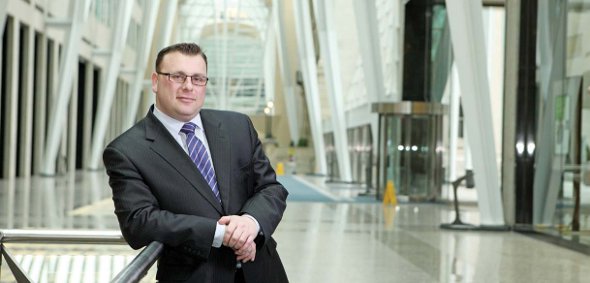
In the studio, I have access to a wide range of lighting and backdrops – on location, I have to consider the logistics of the assignment, the setting, and the desired results. My subjects often have a limited amount of time, and that means I have to travel light, with equipment that sets up quickly, packs up even faster, and delivers professional quality.
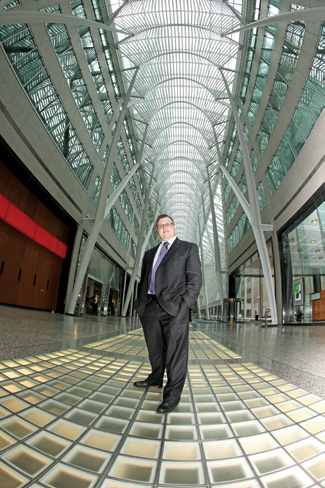 I have a portable lighting kit that lets me set up a portrait studio on location. Even in a tight space with no electrical outlets, I can get the professional look without compromising on quality. ‘
I have a portable lighting kit that lets me set up a portrait studio on location. Even in a tight space with no electrical outlets, I can get the professional look without compromising on quality. ‘
Going downtown with very heavy equipment can be a challenge – just hiking from the parking lot to the client’s office can be exhausting! That’s why I go on location with my camera bag, a bag with three Qflash units and Turbo batteries, a portable backdrop, and three Manfrotto 1052BAC light stands.
Portability is the key, but your location lighting has to be professional caliber – you have to arrive on site, set up, and start shooting right away.
For location assignments, I use my Canon 1D Mark IV, and a selection of portrait prime lenses – the 135mm f/2.8 is a favourite, but for fast-moving assignments I often pick a 70-200 f/2.8 zoom. I arrive on location and usually set up all three Qflash units. I mount the main Qflash on a Custom Bracket. I am left-handed, so the provision to adjust the bracket to the “wrong” side of the camera is a big help. When you power the Qflash with a Quantum Turbo battery on a shoulder strap or on your belt, the camera, flash, and bracket actually weigh less than your camera with a 580 EX II flash and batteries. The bracket lets you separate the flash from the lens axis to prevent red-eye, and mounting the flash higher above the lens axis angles the light down enough to reduce or eliminate shadows behind your subject.
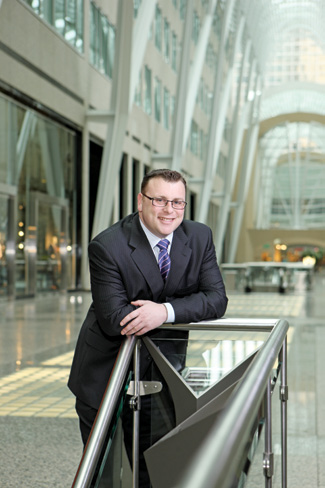
I power each of my Qflash units with Quantum Turbo 2×2 batteries, and I generally get 1200 shots per charge. The new Q3 battery is smaller and more powerful, which is a major plus. Most of my Quantum Turbo batteries are five years old or more, and they just keep on working, year after year, with no loss of power or capacity.
All of the Quantum batteries have an LED read-out, showing how much battery power is left. The Quantum batteries also recycle very fast, especially when you shoot in TTL flash mode. The QFlash is made to handle rapid shooting over a long session.
Standard shoe-mount flashes tend to overheat when used in a professional situation – take too many shots in too short a time frame and the standard flashes will shut themselves down until they cool off. The QFlash just keeps on working.
I have several Qflash units, of different vintages, and they all work together as a team. I use a Qflash Trio as my main light, for the remote flash I use the T5d because it is more powerful, and gives one full aperture over my older Qflash, which I use as a background light – every now and then I turn it around to act as a rim light to separate the subject from the background.
Light management in the studio generally involves softboxes and umbrellas, but these can be a problem when shooting outdoors, or in tight spaces. On location, I prefer the halo softbox as my main light, and I use the diffusers provided by Qflash.
What I like about the Qflash system is that even if the second flash is in the softbox, I have full control over the slave flash from the on-camera flash. While I use the flashes in manual mode most of the time, they work very well in TTL mode – I find the Qflash automatic modes to be more accurate than the camera’s TTL flash system, and you can limit the sensor on the Qflash – you can “tell” the flash how far you are from the main subject, and it will ignore the background light and other ambient lighting that would skew the exposure. This is a real plus when you have strong backlight situations that defeat the camera TTL sensor readings. The Qflash is very versatile – and when you only need a little bit of fill, you can dial down the power to shoot at f/1.4 at 800 ISO.
There are excellent videos on the Qflash website, where Will Crockett explains the Qflash products, and shows you how to set up your location lighting studio – you can find the videos at www.quantum-flash.ca.
The parabolic reflector of the Qflash gives you a much better quality of light than the small shoe mount flash units from the various camera manufacturers. The surface area of the Qflash reflector is about four times the size of the typical shoe mount flash, and you get a circular catch light in the subject’s eyes, which I prefer to the rectangular catch light from conventional flashes. You can also remove the parabolic reflector and use the Qflash as a bare bulb light, which gives 360° light.
Lighting Techniques
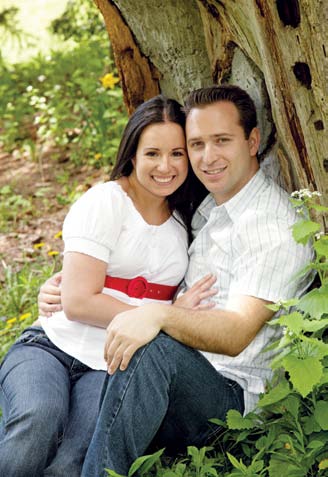 My preference in portrait photography is to use flash in a subtle manner to light the subject, I like the natural look, with just the right amount of fill-in flash. I have a formula that works for me – I underexpose the subject by about 1/3 of a stop, and I set the flash to –1, and that adds just enough flash to balance the flash and ambient light. It is a balancing act – you subtract light from the ambient exposure, and add light from the flash. This lets me control the quantity of the light and the quality – the accuracy and colour consistency of the Qflash makes this technique very successful.
My preference in portrait photography is to use flash in a subtle manner to light the subject, I like the natural look, with just the right amount of fill-in flash. I have a formula that works for me – I underexpose the subject by about 1/3 of a stop, and I set the flash to –1, and that adds just enough flash to balance the flash and ambient light. It is a balancing act – you subtract light from the ambient exposure, and add light from the flash. This lets me control the quantity of the light and the quality – the accuracy and colour consistency of the Qflash makes this technique very successful.
Because I shoot weddings, where the colour of the bridal gown is critical, and exposure is always a concern, I like to set custom white balance with a gray card, but for general subjects you don’t really have to go to this extent to get excellent results – the Qflash system communicates the colour temperature of the flash to the camera, so even if you shoot using auto white balance, the images will be very good right out of the camera.
When you are just starting out, you have to second-guess your camera system – when you are shooting dark subjects, like a bridegroom in a black tuxedo, you have to cut the flash power 1 stop to 2 stops, and when you shoot a bride in a white gown you set the flash to + 1/3 or + 2/3 to keep the details in the dress.
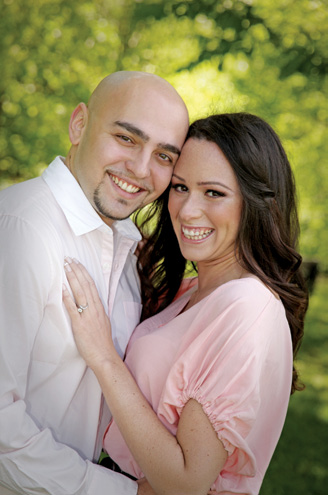 For location shots, I like to set up my subjects in the shade with a well-lit background. I balance my flash with the ambient light for great exposures. The direction of the light can make or break the shot – you want to have your flash coming from the same general direction as the sunlight so you don’t have conflicting shadows.
For location shots, I like to set up my subjects in the shade with a well-lit background. I balance my flash with the ambient light for great exposures. The direction of the light can make or break the shot – you want to have your flash coming from the same general direction as the sunlight so you don’t have conflicting shadows.
If there are no shaded areas available, I sometimes shoot against the sun, letting the ambient light provide a natural rim light, and I balance the light with flash. You want the face to be in the shade so that when you add flash you don’t get too harsh a lighting effect.
The secret of good flash in portraiture is to make it look like there was no flash at all – the flash is there to help the lighting – you want to balance ambient light with fill light, although in some situations, like theatrical poses, you may want the more dramatic “look”.
When I shoot people against a landscape background I set the Qflash to HSS (High Speed Synchronization) and I shoot at a very high shutter speed to capture the background, and the Qflash illuminates the subject. Without the fill-in flash, the subject would be almost a silhouette against the background.
With the new firmware, the Qflash can be used for HSS, and as soon as you drop the shutter speed of the camera the flash automatically switches to normal flash mode – increase shutter speed and the Qflash goes into HSS mode – so you don’t have to stop and reset the flash.
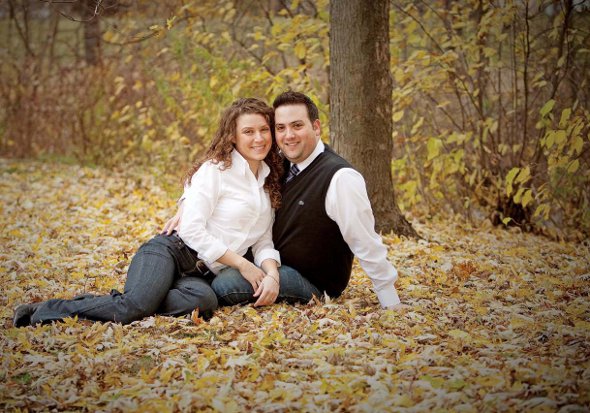
Take a look at the technical data accompanying the photos, and use this as a starting point to develop your own location lighting style – make notes on the position and settings of each piece of equipment so you can duplicate the results, and before long you will be the master of your own location lighting system!
Location lighting for the avid photographer
Can the photo enthusiast produce similar results with conventional equipment? Absolutely! The modern shoe mount flashes, like the new Metz 58 AF2 and 50 AF1 work beautifully in wireless TTL mode, giving you lots of creative potential. You can set up a three-flash portrait using any of the mid-range to top-level DSLR cameras. You may not have the output of the Qflash units that I use, but you can certainly work within the specs of the smaller flashes – the technique is the same, the position of the lights is the same, and you can manage the flash output with a range of accessories like the Lumiquest Softbox II and the Pocket Bouncer.
The Metz 58 AF 2 flash has an advantage when you shoot in a small room – you can bounce the flash off the ceiling, and the secondary flash gives you a nice catch light in the subject’s eye. The latest Metz models have repositioned the slave sensors, giving you excellent communication between the wireless master and slave units.
I like to use the Metz flashes in settings where speed and mobility are essential – I soften the light with a Lumiquest Softbox II and the results are excellent. If you use more than one camera system ask your photo retailer to show you the Metz units that have dedicated modules for each of the major camera brands.
| PHOTONews on Facebook | PHOTONews on Twitter |







